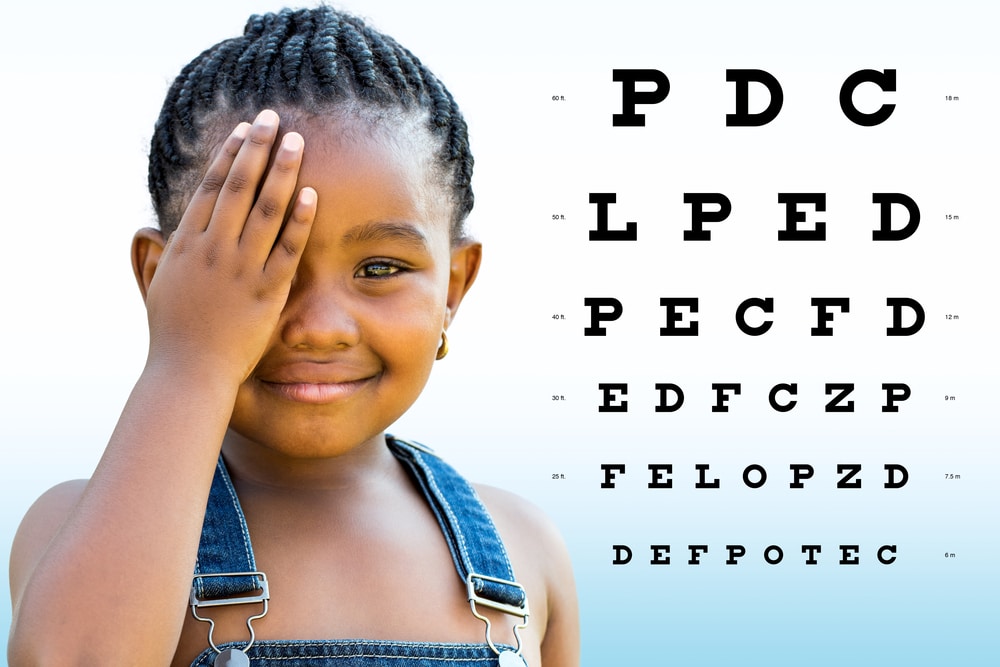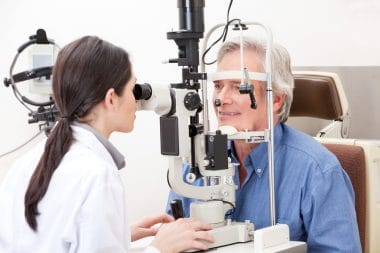To raise awareness of eye health across all ages, Professional Services Manager, Roshni Patel, BSc (Hons) MCOptom, at Lenstore, looks into the life cycle of the eye, examining the most common conditions to look out for from birth to old age, and the treatments available.
Our sight is one of our most valued senses and throughout our lives it is important to take care and protect our vision from possible risks. From birth to old age, we are at risk of developing various eye conditions.
In this article, we will explore the most common eye conditions that can emerge during each stage in our life cycle, examine the causes, and look at ways to help manage and prevent them.
Birth and Early Childhood
In the first year of life, babies’ vision develops quickly, but it takes several months before they are able to focus properly. With their sight developing in these first critical months, it is not uncommon if your baby’s gaze is wondering or unfocussed. Changing eye colour is also completely normal.
However, as they develop you should watch out for irritation in or around the eye, light sensitivity, or erratic eye movement, all of which can be symptoms of different conditions, discussed in more detail below.
Strabismus or “Squint”
A squint is the misalignment of eyes due to the muscles failing to work properly together. This can also be a sign of a lazy eye. It can be identified in infants of around four months where their eyes fail to look in the same direction.
A child that you think might have strabismus should be taken to an eye specialist, who will likely treat it with special glasses, eye exercises, or in some cases, targeted injections and surgery.
Lazy Eye/Amblyopia
Amblyopia, more commonly known as lazy eye, is a condition in which one eye becomes weaker than the other, and visual acuity decreases. It’s often caused by an initial weakness in one eye that causes it to become underused.
The affected eye can also develop a squint, which, in some cases, makes it easier to identify a lazy eye, especially in younger children who may not always report that they can’t see as well through one eye. In those where a squint is not present, amblyopia might, instead, be noticed as difficulty in reading and writing. If your child does show signs of struggling with these, it should be reported to an eye specialist who can perform further tests.
Amblyopia is treated by using glasses or eye exercises to improve focus, though surgery may be considered in some cases. An eye patch may also be used to force the use of the weaker eye to strengthen it, while surgery may be considered if the child has a squint.
As your child ages, it becomes progressively more difficult to treat a lazy eye. The critical period is often regarded as up to the age of nine, though there is some research indicating that it’s still possible to reverse amblyopia up to the age of 17. Regardless, it should be considered vital to have your child undergo regular eye tests from a young age to catch it as soon as possible and allow for the most effective treatment.
Nystagmus
Nystagmus is a condition in which your child’s eyes may move erratically and cause them difficulty to see clearly.
While there is no cure for this condition, glasses or contact lenses may assist with your child’s vision. Ask your optometrist for their recommendation.
Primary Congenital Glaucoma
This form of glaucoma is developmental and may occur as a result of a birth defect. It usually occurs before the age of three due to an obstruction in the eye from abnormal development.
Symptoms include poor peripheral vision, a clouded cornea, unusually large eyes, and sensitivity to light. Babies affected by the condition may become irritable and refuse to feed as a result.
Treatment should be handled by your eye specialist who will advise on the best course of action, and this should be addressed as quickly as possible. It may involve surgery, though medical therapy has been found to help in some cases.
Congenital Nasolacrimal Duct Obstruction (CNLDO)
As a common condition among infants, CNLDO affects as many as 20% of children under one year of age and is usually resolved without the need for surgery. Visible symptoms include redness of the lower eyelid skin and excessive watering of the eye.
It is important to seek advice from an eye specialist before considering surgery since treatment often includes a gentle massage of the lacrimal sac to expel discharge several times a day.
Retinoblastoma
Retinoblastoma is a cancer of the eye. In 9 out of 10 cases it is caught early and treated before it spreads beyond the eye. Nevertheless, spotting signs of it is the best way to protect your child. Symptoms include an unusual white reflection in the pupil (noticeable with flash photography), a squint, a red or inflamed eye, or poor vision (if your child is able to report it). If you have a family history of retinoblastoma, mention it to your GP during pregnancy as they may suggest a screening for it after birth.
Once spotted, treatment depends on the case. It may include laser treatment or freezing the tumour, or surgery or chemotherapy, and specialist doctors will provide more information about the best steps to take to treat it.
Measles
While measles isn’t directly a disease of the eye, it can cause vision loss and even blindness since it can damage the cornea, causing it to become hazy and discoloured. As such, vaccinating your child against measles (usually as part of the MMR vaccine also incorporating mumps and rubella) is vital to ensure their eyesight is protected.
If your child develops a fever, cough, conjunctivitis, and runny nose, you should consult their GP to identify treatment options and protect them from any lasting concerns arising from the disease.
Pink Eye/Conjunctivitis
This condition is particularly common when children start to attend nursery and childcare services, with it developing into an infection from a virus or bacteria. Conjunctivitis is a common condition in which an eye becomes red and irritated and often results in discharge from the eye that may become sticky and gather in the eyelashes. It’s treated effectively in the majority of cases with antibiotic drops or ointments, though babies are usually treated with a different, specific antibiotic.
Colour Deficiency
All children in the UK undergoing their first eye exam receive a colour vision test that should pick up any issues with colour blindness or colour deficiency. Without tests, it can be tough to spot colour deficiency as children are unlikely to know there is an issue, but you may identify it if they have difficulty differentiating colours. It presents itself in two forms. The first, difficulty identifying brightness in certain colours, and second, trouble telling the difference between different shades, often of red and green or blue and yellow.
While there is no cure for colour deficiency, special contact lenses and glasses are being researched and developed that may treat the effects of the condition.
Digital Eye Strain
A problem arising more commonly in recent years among children of all ages is prolonged exposure to screens without breaks. This can cause eye strain due to glare and light reflecting from the screens. To prevent your child from suffering from eye fatigue, which may weaken their vision, it’s important to try to get them to balance their screen time with other activities (ideally outdoors), as well as take regular breaks from screens.
It’s recommended that you follow the 20-20-20 rule: every 20 minutes of screen time, have your child take a 20-second break to look at something 20 feet or more away.
Adolescents
Some key factors to pay attention to among adolescents are injuries that may be as a result of sports or an active lifestyle, especially since injuries can cause trauma to the eye. If your child reports any difficulty seeing, this may indicate developing issues in their eyesight which should be addressed with their optician. You can find more details below:
Refractive Errors
Refractive errors usually develop slightly sooner than puberty, with family history having an impact on the time of development. Whilst refractive errors can result in long-sightedness and astigmatism, it is more likely to see the emergence of short-sightedness, which occurs as a result of the growth of the eye. Signs of refractive errors may include experiencing blurry vision at certain distances, perhaps seeing the board at school, or problems seeing more generally.
Adolescents should have eye tests regularly to identify any difficulties they may be having. Treatment is likely to be the use of glasses or contact lenses.
Keratoconus
Keratoconus is a progressive thinning or change in the shape of the cornea, resulting in blurry or distorted vision, and sensitivity to light. It often begins at puberty and is most commonly seen among teenagers and young adults. The condition is also often associated with general atopic conditions such as eczema and asthma.
Keratoconus is commonly treated with glasses or specialist contact lenses which your eye specialist can prescribe.
Traumatic Cataracts and Retinal Detachments
As teenagers become more active, injuries may cause trauma to the eye, including traumatic cataracts or the detachment of the retina. The best way to deal with this is prevention rather than treatment, and eye protection while playing sports can often make a difference.
However, if your child has had an injury and reports a reduction/loss in vision, pain when moving their eye around, flashes or floaters in their vision, halos around lights, or shows sensitivity to light, you should take them to see an eye specialist without delay.
Adulthood: 20-40 Years of Age
As we become adults, much of the developmental stage of our eyesight is over, but there are still steps we can take to protect our vision. Although we should have a healthy lifestyle by eating a balanced diet with plenty of antioxidants, avoid smoking, and keep exercising regularly, there are eye conditions to be aware of:
Blue Light
As with digital eye strain, staring at a screen for long periods isn’t great for your eyes. In particular, certain wavelengths of blue light, which can emanate from most digital devices, can cause eye fatigue and eye strain. You can get special glasses that can block out some of this light to protect your eyes as well as computer and mobile phone software which can filter out some of the blue light.
Similarly, enjoying the sunshine too much can cause issues; make sure to wear sunglasses with UV-A and UV-B protection.
Optic Neuritis/Retrobulbar Optic Neuritis
Optic neuritis, an inflammation of the optic nerve, may occur in isolation or as a manifestation of multiple sclerosis. It is usually more common in women than in men.
Symptoms include loss of vision or colour vision (usually red), or pain when moving your eye, and should be reported to your eye specialist immediately.
Retinitis Pigmentosa
Retinitis pigmentosa is a group of diseases affecting the retina. It’s caused by genetic mutation and results in gradual sight loss starting with low-light vision and peripheral vision. If you start having vision loss or if your family has a history of retinitis pigmentosa, you should let your doctor know as they can provide further information and advice. There is, however, no cure or treatment available at this time.
Adulthood: 40-60 years of age
Among the most common changes in eyesight as we reach middle age is a decrease in the ability to see at close distances, which often presents difficulty reading. This change is called presbyopia and progresses over time. Those already wearing glasses or contact lenses will be able to correct this with multifocal lenses. This natural change should not be confused with symptoms of general blurriness, light sensitivity, dryness, or inflammation, which may be symptoms of cataracts, glaucoma, or other diseases, discussed below:
Cataracts
Visible as a clouding of the lens in the eye, cataracts are usually a result of ageing and are very common in older people. The condition can also be brought on prematurely from certain health conditions and medications such as steroids.
Symptoms of cataracts may include blurry vision, faded colours, sensitivity to light, a reduction in the ability to see at night, and double vision. Your eye specialist may recommend surgery to remove cataracts and replace them with an artificial lens.
Glaucoma
Glaucoma can often go unnoticed for a long time due to minimal symptoms. While it can occur in anyone, there is a higher risk among certain groups, including older people, those of African, Caribbean or Asian descent, and anyone with a family history of the condition or with diabetes, short-sightedness (open-angle glaucoma) or long-sightedness (closed-angle glaucoma).
The condition emerges as a result of intraocular pressure building in your eye, which can then result in a variety of symptoms depending on the type of glaucoma. This can range from no symptoms to blurred vision and rainbow-coloured circles around bright lights or severe eye pain and nausea and vomiting.
While glaucoma can’t be cured, several treatments can slow its progression, including eye drops, laser treatment, or surgery. After the damage has been done, it can’t be reversed, so it’s important to get regular eye checks so it can be identified before it has any significant effect on your vision.
Dry Eye
Dry eyes are a condition that sees the disruption of tear film that is used to hydrate your eyes and protect your vision. As a result, your eyes become dry and irritated, making your eyes uncomfortable and impacting the clarity of your vision.
Most commonly this leads to discomfort in the eyes, including burning or stinging, a sensation of particles being in your eyes, itchiness, inflammation, sensitivity to smoke, and mucus build up in your eyes, usually in the mornings.
While there is no cure, it can be managed to an extent with over-the-counter artificial eye drops and some ointments. Your eye specialist will be able to advise on the best treatment for you.
You may also wish to consider using a humidifier at home to keep natural moisture in the air to slow the drying of your eyes, and when using a screen, follow the 20-20-20 rule: every 20 minutes, look at something 20 feet away for 20 seconds to allow your eyes a chance to recover. Blinking regularly can also help reduce drying of your eyes, as we tend to blink significantly less when looking at a screen, causing our eyes to dry out.
Uveitis
Uveitis is an inflammation of the eye that can be acute or chronic and can take several different forms, including anterior, intermediate, or posterior uveitis, each with different symptoms and treatments.
The most common is anterior uveitis, and while it can occur at any age, it’s more common amongst working-age adults. Risk factors include injury, surgery, infection, and inflammatory or autoimmune conditions such as crohn’s or sarcoidosis respectively. It can be serious and lead to permanent vision loss. It is, therefore, important to watch for floating spots, reduced vision, redness, pain, light sensitivity, or blurred vision, and report it to an eye specialist as soon as it’s noticed.
For anterior uveitis, your eye specialist will likely prescribe corticosteroids eye drops to treat it, as well as dilating drops, if needed, to help with pain and to protect against the formation of synechiae, adhesions of the iris either to the cornea or the lens, which can have long term impact.
For forms other than anterior uveitis, treatment can be administered in the form of injections, oral medication, or implants.
60+ Years of Age
For those that are aged 60 and above, age-related degradation of the eye and vision is likely to take place. Presbyopia will continue, prompting a need for reading glasses or multifocal contact lenses, but if you are having difficulty reading, ensure that you pay close attention to the exact symptoms. Distorted vision or floaters are indications of other issues and should be addressed with your eye specialist as soon as possible.
Age-Related Macular Degeneration (AMD)
Common among people over the age of 50 or 60, macular degeneration has no known primary cause, though higher risk factors may include smoking, high blood pressure, and being overweight, as well as any family history of the condition.
It reduces your ability to read and recognise faces as it affects the central part of the vision rather than the periphery. You’ll most likely notice it as a blurred or distorted area in your vision, though vision loss is possible, and you may see straight lines as wavy or crooked. Objects may look smaller than normal, and colours may seem less bright. It may progressively get worse.
Depending on the variant, AMD may be treated with regular eye injections or managed with vision aids to minimise its effects.
Symptomatic Vitreomacular Adhesion
For most people, as they age, the gel that fills the eye, known as the vitreous, liquifies and loses shape, which can cause it to detach from the retina at the back of the eye, also known as a posterior vitreous detachment. While this is a common change for older people, the separation can be incomplete and areas of the vitreous can remain attached to part of the retina, the macula, and pull on it, which causes this condition.
This can distort your vision, and in severe cases, cause a loss of central vision. Treatment usually involves “watchful waiting” — that is, waiting until the condition reaches a point where more dramatic treatment becomes necessary to deal with severe symptoms. In this treatment, the vitreous gel is surgically removed or medication is injected into the eye.
Retinal detachment is where the thin layer at the back of your eye, known as the retina, becomes disconnected from the rest of the eye. It’s more common in those who have suffered a recent injury or undergone surgery to the eye or those who are short-sighted or have a family history of retinal detachment.
It can present itself as sudden dots or lines (“floaters”) in your vision, sometimes with flashes of light or a dark shadow in your vision. Treatment should be as soon as possible to prevent permanent damage to your sight, and usually involves surgery, which will require some recovery time.
Central Retinal Vein Occlusion (CRVO)
It is possible for the vein that carries blood away from the eye to become blocked, which then leaks blood and fluid into the retina. This can collect in the macula (part of the retina) leading to macula swelling (oedema), causing blurred vision or vision loss. People with diabetes and hypertension are at a greater risk of developing this condition.
No treatment is available to resolve the core issue, but complications can be treated so you need to consult with an eye specialist. Complications rarely include long-term blindness; more common is chronic macular oedema and cystoid macular oedema, which can cause blurred or decreased central vision.
Consulting with your doctor is especially important as CRVO can cause neovascular glaucoma to develop, which needs to be constantly monitored, as it can cause pain and decreased vision leading to permanent blindness.
Conclusion
Regardless of where you are in life, your eyes are best protected with a healthy diet and lifestyle. Ensure you’re getting plenty of rest, keep screen time to a minimum, exercise regularly, and get regular eye check-ups. Being aware of these eye conditions throughout your lifetime will also enable you to keep your sight in good condition.








Reply